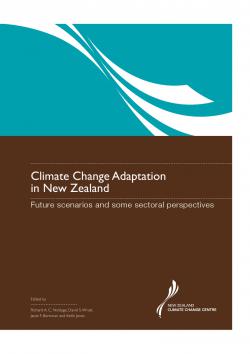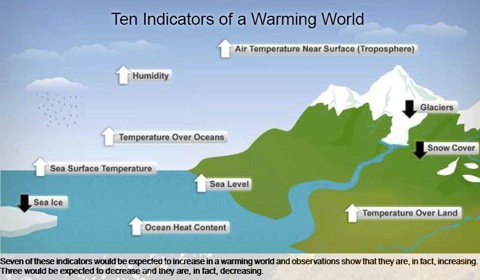 When I first began to realise what a serious matter climate change was I found it difficult to get interested in adaptation. It sounded to me like acceptance of something that should be resisted. And I disliked the bland voices claiming that the effects of global warming would be easily adapted to if not positively beneficial. However with time I’ve recognised that there is no escaping adaptation. It is as much a part of coping with the threat of climate change as mitigation, and the one doesn’t displace the other. Indeed the need for adaptation may sharpen awareness and spur determination to turn away from fossil fuel energy.
When I first began to realise what a serious matter climate change was I found it difficult to get interested in adaptation. It sounded to me like acceptance of something that should be resisted. And I disliked the bland voices claiming that the effects of global warming would be easily adapted to if not positively beneficial. However with time I’ve recognised that there is no escaping adaptation. It is as much a part of coping with the threat of climate change as mitigation, and the one doesn’t displace the other. Indeed the need for adaptation may sharpen awareness and spur determination to turn away from fossil fuel energy.
New Zealand appears unlikely to be one of the worst-affected countries as climate change begins to bite. But changes will occur and adaptive responses be demanded. The Climate Change Centre’s recent publication Climate Change Adaptation in New Zealand: Future scenarios and some sectoral perspectives (pdf download here) is a contribution from the scientific community towards discerning what form those responses may need to take. Gareth announced its publication a few weeks back and over coming weeks I’ll try to report on at least some of the chapters. I’m starting with a look at the second chapter Global & local climate change scenarios to support adaptation in New Zealand, written by Andy Reisinger and four others.
What will we need to adapt to? That depends on what the world does about future carbon emissions. The paper selects and explores two different global scenarios following divergent emissions pathways. One is a high carbon world. It assumes that there will be no concerted efforts to reduce greenhouse gas emissions. It represents a fractured world with varying socio-economic and technological development in different geographical areas. It will likely result in large rates of climate change, warming of almost 4 degrees above pre-industrial levels by the end of the century, and severe impacts in many regions.
The other scenario is of a rapidly decarbonising world with rapid concerted global action to reduce greenhouse gas emissions and to limit greenhouse gas and aerosol concentrations to about 450 ppm CO2-equivalent. This results in a long-term increase in global temperature of about 2 degrees above pre-industrial levels. In this scenario the global impacts of climate change impacts would be limited in their severity and extent, but some regions would still experience significant negative impacts.
The paper envisages possible strains between the two nations in the high carbon scenario, including population pressure on New Zealand and a more protectionist stance in Australia.
Before moving to specific effects on New Zealand climate the paper discusses the possible flow-on effects for us from the more generalised global impacts of the changing climate. Our near neighbour Australia, likely to suffer severe effects from climate change, figures largely in these considerations. The paper envisages possible strains between the two nations in the high carbon scenario, including population pressure on New Zealand and a more protectionist stance in Australia. Under the rapidly decarbonising scenario by contrast we could expect a more harmonised and cooperative approach to mitigation and adaptation. In relation to the wider world the paper points to a number of possible effects for New Zealand in the high carbon scenario ranging from instability in the Pacific Islands to possible new international trade barriers and new alliance groupings. In the rapidly decarbonising world we can expect some benefits from the changes in energy production systems and technologies, as well as some costs. International trade agreements are likely to be linked to climate and environmental efficiency standards.
The paper then turns to specific climate changes in New Zealand, focusing mainly on temperature and precipitation. One or two things struck me particularly in this section. In relation to temperature it is in the latter half of the century that the high carbon scenario diverges most strikingly from the rapidly decarbonising scenario. Projected temperatures rises in New Zealand are below the global average, but coping with around a 1.25 degree change by the end of the century looks much preferable to the around 2.5 degrees over much of the country that is projected under the high carbon scenario. Precipitation changes show a strong west-east gradient driven by the expected increase in southern hemisphere westerly winds. The increases in the west and decreases in the east are markedly stronger in the high carbon scenario by the end of the century.
In treating other climate elements and extremes in New Zealand the paper is less specific, on the grounds that not enough scientific work has yet been done. However in the matter of temperature extremes it finds decreases in frost occurrence and increases in high maximum temperatures are robust findings. It expects roughly that by the 2030s what is currently an unusually warm year will have become the norm, and an unusually warm year in the 2030s will be outside the ranges of temperature experienced in New Zealand to date.
On precipitation extremes it suggests that a currently experienced extreme rainfall with a 100-year return period could occur approximately twice as often under a local warming of about 2 degrees. It notes that increasing flood peaks resulting from these extremes will interact with rising sea levels.
Drought magnitude and frequency are expected to increase, with the possibility of a current 1-in-20 year drought occurring at least twice as often in some eastern areas under a warming of about 2 degrees. Fire risks are likely to be more marked, especially in eastern areas.
Sea level rise receives separate attention. The paper suggests that coastal risk assessments should assume that the probability of sea level rise of at least 0.5 m by 2100 is high, but the possibility of even 2 m cannot be absolutely excluded and sea level will continue to rise beyond 2100 for many more centuries. Compounding factors such as storm surges and changes in wave patterns need to be taken into account.
It would be a mistake to assume that, because the climate changes projected for New Zealand are relatively lesser in rate and magnitude compared to the rest of the world, adaptation is therefore a less important question for us. Sea level rise will be at least the global average of change. Effective management of the large range of ecosystems and natural hazards is constrained by our small budgets and pools of expertise to inform decisions, all the more because of our decentralised approach to decision-making in such areas. We are strongly linked to global processes through international policies, technologies, trade and flow of people and goods and services and must be sensitive to this.
There’s much for New Zealand to be concerned with internally in the ongoing process of adaptation. Climate risk assessment should precede new infrastructure development. Difficult conflicts may be associated with the loss of opportunity in, for example, the development of a coastal property because of its vulnerability to future sea level rise. The danger of local councils with limited resources being captured by special interests raises the question of the extent to which binding guidance should be provided to councils by central government on matters of adaptation.
As the selection of scenarios indicates, we can’t be sure what adaptive measures will be required in the future. But we will have no reason to be taken by surprise.

